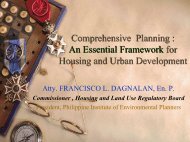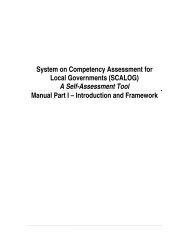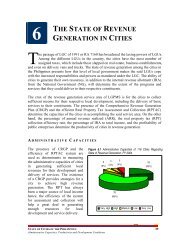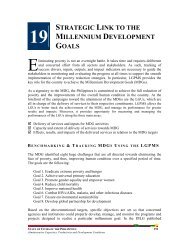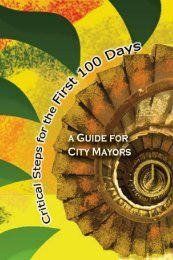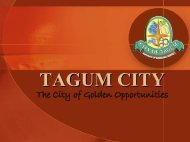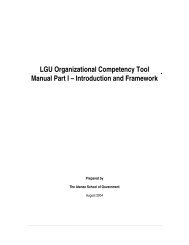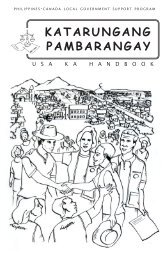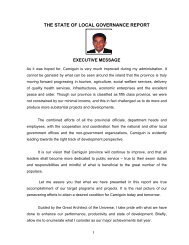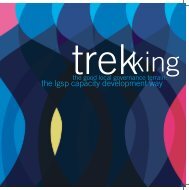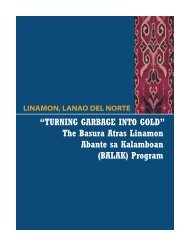Sigma 2005 - LGRC DILG 10
Sigma 2005 - LGRC DILG 10
Sigma 2005 - LGRC DILG 10
Create successful ePaper yourself
Turn your PDF publications into a flip-book with our unique Google optimized e-Paper software.
Kasama Ka!: Multistakeholder Partnerships for Solid Waste Management<br />
SIGMA, CAPIZ<br />
implementing the SWM Plan. Municipal ordinances were also put in place<br />
to help enforce participation and compliance in the program at the<br />
community level.<br />
5. Designating a lead implementor<br />
After getting the plan approved and ready for implementation, the next<br />
step is to designate a lead agency to implement it. In the case of <strong>Sigma</strong>,<br />
the LGU recognized that the magnitude of the program meant it needed<br />
external expertise and additional personnel in managing it. It therefore<br />
came up with an innovative mechanism –- engaging the services of a<br />
<strong>Sigma</strong>-based NGO, SDFI, to take the lead in managing the program.<br />
A Memorandum of Agreement (MOA) between the Municipality of <strong>Sigma</strong><br />
and SDFI was signed in March 2003, authorizing the latter to manage the<br />
program jointly with the LGU, under the policies set forth by the MSWM<br />
Board. (See Annex B for the Memorandum of Agreement)<br />
6. Conducting capacity development activities for program implementors<br />
This step can go hand-in-hand with the formulation of the plan and should<br />
include the development of a capacity development plan or program with<br />
resources allocated and the implementation of such a plan/program. In<br />
<strong>Sigma</strong>, the SWM Board started crafting the <strong>10</strong>-year comprehensive SWM<br />
plan during a series of training and demonstration projects. The training<br />
program included the following key SWM components:<br />
o<br />
o<br />
Orientation on solid waste and other environment-related issues<br />
A three-day trainers’ training facilitated by the DENR and attended<br />
by 33 participants from schools, barangay officials, NGOs, business<br />
people, municipal employees and the SWMB<br />
7. Operationalizing the program, including the 4Es<br />
7.1 Defining the pilot or focus areas<br />
In <strong>Sigma</strong>, the program was piloted in the municipality’s two urban<br />
barangays, Poblacion Norte and Poblacion Sur, which together<br />
comprise the town center and where the greatest volume of solid<br />
waste is generated. The two barangays have a combined population<br />
of 3,042 or 603 households representing 11% of the population. The<br />
two barangays were selected for piloting because most of the major<br />
institutions (and identified major generators of waste) in the<br />
October <strong>2005</strong> 9



